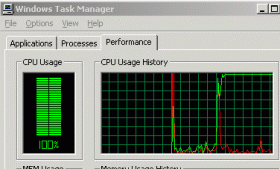Munk, the entire time I was reading the article, I was still clinging to what I had always believed, that being exactly what you stated. I'm going to ellaborate on what I had previously understood, perris, simply so that you can get a better understanding on what we are talking about and correct us if need be.
As far as I have been aware, Task Manager represents the entire 100% of your CPU usage. Therefore, if you are running a game that task manager displays as having a CPU Usage of 100% (quite a common scenario in the gaming world) then the Idle Process will drop right down to 0%. However, if you were making no load (or very little - say about 2%), then the System Idle Process will jump up to 98%.
So as an example, say you are using about 10% of your CPU, what happens to the other 90%? Your processor cannot simply sit there and do "nothing" with that 90%, therefore it runs the "System Idle Process" to make up the remaining CPU cycles. Task Manager will then display the Idle Process as having 90% usage.
Therefore, if you take the 10% you are using (say in explorer and word) and add it to the System Idle Process (being 90%) then you will get exactly 100%.
And this is true for any circumstance. If you add up the usage of each of the processes running on your system and it is below 100, then the System Idle Process will always display the remaining percentage to make up a total of 100%.
This is what Monk was trying to demonstrate with the screenshots.
When you said:
most users usually have the processors running aobut 10-20% of the max...of that percentage, the most of the cycles are doing nothing at all,and the system idle process carries those wasted cycles
I think that seems to match up with what we are saying.
However, I think the confusion has arrisen due to statements such as:
it's not 90% of your CPU that it's taking, it's 90% of what the CPU's load is for instance, go to the performance graph...if the CPU's load is 1%, and system idle is using 90% at that time, then system idle process is using 90% of the one percent. in other words, 9/10th's of one percent in this example
I still don't really understand that example. Firstly, it's a bit misleading because we know that the total amount must add to 100% so it should either be 99% (load) + 1% (system idle process) or 90% + 10%. But apart from that, I never really saw the System Idle Process as being a percentage of the "current" load. A percentage of the "total" load maybe, but not of the current load..? Otherwise it would not explain why the System Idle Process
decreases when the load
increases (at an exact rate which always seems to add to 100%). It's more like a remainder, the remainder of your total CPU usage, based on the amount you are currently using.
I think the primary difference between the arguments is that you are multiplying the System Idle Process against the load (which produces the weird fraction), while we are instead adding them together (which always produces an exact 100%, seeming to represent the total load)
But it's interesting nonetheless! I'll have to read up a bit more into it another time but unfortunately I have my major end of school exams (which decides which uni I get into) over the next three weeks so I'll have to be studying

(But at least I have FOUR MONTHS holidays to look forward to after them

)
Anyways, thanks perris for the great explanation regarding the specific workings of the CPU, it is very informational (and very advanced! lol).
Patrick













